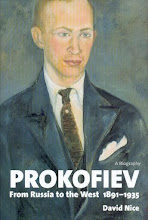Here, in the pink thanks partly to the lighting, are two pianists from among past winners: Lara Melda (2010's victor, then known as Lara Ömeroğlu) and Martin James Bartlett, 17 when he took first prize along with saxophonist Alexander Bone in 2014. Perhaps the one significant step forward for the BBC Proms this summer is to bring together 21 Young Musicians of the Year (as they were formerly called) in a single concert, marking the event's 40th anniversary. Lara and Martin will be repeating their tour de force, featured first time round with the Aurora Orchestra, as specimens in the 'grand zoological fantasy' of Saint-Saëns' Carnival of the Animals, always a delight. Who'll play the Swan? Sheku Kanneh-Mason or one of the other three cellists represented, including Sheku's mentor Guy Johnston?
The reception had a special setting this year, after many sweltering gatherings in the Amaryllis Fleming Concert Hall of the Royal College of Music - the Imperial War Museum, looking less grim and Bedlamish than usual on a day of summer-in-spring. My photos of the gathering were taken before and after the great throng, from which you'll gather I lasted the duration.
The reason for the location was the Proms' commemorating the centenary of the last year of the First World War. The theme reminded me that my paternal grandfather's reconnaissance mission at the Front took place on 7 April 1918 in Fampoux Field to the east of Athies, 100 years ago this month. As related in the History of the 5th Dragoon Guards published by Blackwood in 1924 in my first entry on Captain George Nice - and it seems apt to repeat it here -
Second Lieutenant Nice of A Squadron was afterwards awarded the Croix de Guerre for his gallantry in reconnoitring under heavy rifle and machine gun fire to try and find a route for the regiment to make a further advance in the direction of Greenland Hill.
1918 was also the year in which Parry completed his richest choral music, the Songs of Farewell. At the launch the BBC Singers gave a very nuanced performance, stilling the party crowd, of 'My soul, there is a country,' the only one of the set I know, from All Saints Banstead days*; I came to marvel at the rest when working on a talk for Tim Reader and his Epiphoni Consort, who sang a selection. Sakari Oramo will conduct the entire set - and I think they do need to be heard in one concert, if not necessarily all together at once - in a Cadogan Hall Prom on 20 August.
Looking through the Proms prospectus - our usual pleasure in revelation at the pre-event gathering with David Pickard and Alan Davey was pre-empted by the untimely morning announcement of the whole lot - the Cadogan events strike me as much the most enticing in terms of repertoire. There aren't many great surprises in the rest, though DP made the very good point that what looks ordinary on paper can be transfigured by the unpredictable magic of the Albert Hall (conversely, it can let some pieces down). And there will be thousands who've never heard Shostakovich 4 before - it has to be worth it from Nelsons and the Boston Symphony.
To my surprise Bernstein's MASS isn't on the cards, a Proms piece if ever there was one - though I've had my vision to last the next five years. West Side Story (complete in concert for the first time) and On the Town are, under the peerless-in-that-rep baton of John Wilson.
Cue my chat with Martin and Lara (I knew the former a bit from his Southrepps recital and trio performance). MJB's quirky imagination revealed itself when we were chatting about Bernstein, I told him how, courtesy of my then editor at The Guardian Ted Greenfield, I shook the great man's hand at a recording session for Candide before he (MJB) was born, and he said that Lenny was the person he'd most like to have met. But then he thought about it and commented that probably you'd have the man's entire attention for five minutes and he would be charming, and then switch it off. Like Ripley.
I did a double-take. Yes, Patricia Highsmith's Talented Mr Ripley as immortalised cinematically in Plein Soleil, which MJB hadn't seen, and Minghella's beautifully filmed, scary and poignant masterpiece, which he had (Matt Damon's Ripley pictured above), and we talked about it, and told Lara she had to see it.
Well, it was a grand evening, and though I sometimes dread the thought of chit-chat, there were so many welcome faces, some of whom I asked along to the Europe Day Concert. Several key folk will be involved in that whom I met at the fabulous Pärnu Music Festival, which is a roundabout way for me to close in saying that the orchestra I'm most looking forward to seeing at the Proms, following the usual heavenly (we hope) week, will be the Estonian Festival Orchestra under Paavo Järvi (a chat with David Pickard at the Multi-Story Orchestra Prom last year encouraged that set-up, I'm told). Here the 2016 vintage is on the beach at Pärnu, a typically wonderful shot by the great Kaupo Kikkas.
Only connect: they'll be opening with Arvo Pärt's Third Symphony, the UK premiere of which father Neeme conducted with the Gothenburg Symphony Orchestra at the Proms in 1989 - an event which led to my first ever visit to Estonia a few weeks later. Terviseks (Estonian for Cheers!) to all those Järvis!
*RIP Choirmaster DAH/David Harding. I can't say much more except that he was the most inspirational figure in my musical education.
























